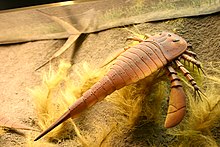Eurypterid
The eurypterids, related to arachnids, were the largest known arthropods. They are members of the extinct order Eurypterida. It is a most diverse Chelicerate order.[1]
| Eurypterid Temporal range: Ordovician–Permian
| |
|---|---|

| |
| Eurypterid from Ernst Haeckel's Kunstformen der Natur (1904) | |
| Scientific classification | |
| Kingdom: | |
| Phylum: | |
| Class: | |
| Order: | † Eurypterida
|

The largest, such as Jaekelopterus, reached 2½ metres in length, but most species were less than 20 cm (8 inches). They were the largest arthropods of all time. They were predators which thrived in the warm, shallow seas and lakes of the Ordovician to the Permian periods, around 460 to 248 million years ago. Recent research suggsts their eyesight was not very good.[2]
The move from the sea to fresh water probably occurred by the Pennsylvanian period. Eurypterids went extinct during the Permian–Triassic extinction event 251 million years ago, and their fossils have a near global distribution.
The typical eurypterid had a large, flat, semicircular carapace, followed by a jointed section, and finally a tapering, flexible tail, most ending with a long spine at the end (Pterygotus, though, had a large flat tail, possibly with a smaller spine). Behind the head of the eurypterids were twelve body segments. These segments are formed by a dorsal plate, called a tergite, and a ventral plate, called a sternite. The tail, known as the telson, is spiked in most eurypterids.[3]
- A recent discovery of a new fossil species of eurypterid, Pentecopterus, has been made. It is two meters long, and lived 467 million years ago, in the Middle Ordovician period.[4][5]
References
change- ↑ Dunlop, J.A.; et al. (2008). "How many species of fossil arachnids are there?". Journal of Arachnology. 36 (2): 267–272. doi:10.1636/CH07-89.1. ISSN 0161-8202. S2CID 42371883.
- ↑ Anderson R.P. et al 2014. What big eyes you have: the ecological role of giant pterygotid eurypterids. Biology Letters 10 (7): 20140412. [1]
- ↑ L. Størmer (1955). "Merostomata". Treatise on invertebrate paleontology, Part P Arthropoda 2, Chelicerata.
- ↑ BBC Radio 5 live. [2]
- ↑ Lamsdell, James C. et al 2015. The oldest described eurypterid: a giant Middle Ordovician (Darriwilian) megalograptid from the Winneshiek Lagerstätte of Iowa. BMC Evolutionary Biology 15: 169. [3]